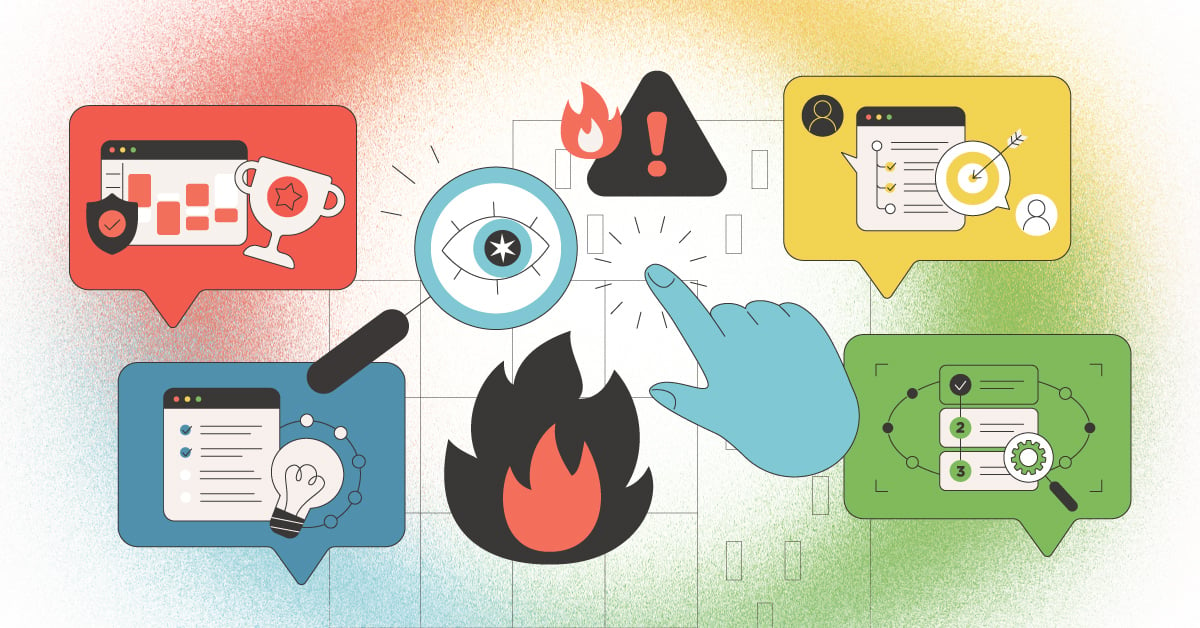
If you’ve ever taken a DISC assessment, you likely have a solid grasp on the “how” of your personal behavior. However, a key to success in all things is self-awareness and awareness of how others perceive you, not just how you perceive yourself.
There’s a section in TTI SI reports that goes over these perceptions, but let’s dig in a little more. Here’s what each Behavioral style looks like to themselves and others in different situations.
Direct Communicators Under Pressure: Unyielding & Unruly
![]() Direct people view themselves as ambitious, decisive, competitive, confident, positive, and leaders. They are people oriented, eager to achieve, and ready to get started ASAP. This self view can be correct under calm circumstances, but what happens when we turn up the heat?
Direct people view themselves as ambitious, decisive, competitive, confident, positive, and leaders. They are people oriented, eager to achieve, and ready to get started ASAP. This self view can be correct under calm circumstances, but what happens when we turn up the heat?
When Direct communicators are under moderate pressure, they tend to double down. Their motto of “Be brief, be bright, be gone” feels less inspirational and more demanding to their slow-paced peers. They can come across as demanding and disruptive of other processes, and this unwillingness to conform comes across as stubbornness and a lack of empathy.
Things take a turn for the worse under extreme circumstances; when pressure takes its toll, Direct people are seen as harsh, controlling, aggressive, and egotistical. What you believe is the best way forward might actually be harming others, but an unwillingness to consider other points of view shuts down collaboration and communication.
How You Can Turn It Around:
Slow down! Not everyone can sprint a marathon like you. Take a deep breath and listen to others. You can’t know best everytime, every way, and that’s not a bad thing. Allow others to voice their opinions before you to temper negative perceptions and create some new, positive ones
Reflective Communicators Under Pressure: Insecure & Intimidated
![]() Reflective people perceive themselves as modest, adaptable, low-key, cooperative, and agreeable. They tend to go with the flow and will yield to others to avoid conflict. Their mild nature makes for agreeable teamwork, but it can cause larger problems when Reflective people don’t stand up for themselves.
Reflective people perceive themselves as modest, adaptable, low-key, cooperative, and agreeable. They tend to go with the flow and will yield to others to avoid conflict. Their mild nature makes for agreeable teamwork, but it can cause larger problems when Reflective people don’t stand up for themselves.
When Reflective communicators are under moderate pressure, others perceive them as docile, hesitant, timid, and fitting into the role of a ‘follower’. This is an issue for Reflective leaders, especially; their tendency to bend to the wills of others can allow them to be walked over or disrespected.
Extreme pressure only dramatizes these tendencies; others perceive Reflective people as intimidated, anxious, insecure, and meek when situations become intense. Their agreeable nature is perceived as an inability or unwillingness to act, which then causes problems down the line.
How You Can Turn It Around:
Fight against your instinct to turn inward when things get difficult. Alleviate your anxiety of disturbing others by focusing on clear communication. Ask for additional clarity when you need it, and make sure interactions and meetings are ended with clear expectations. This will help you feel more confident in your decisions moving forward from that point.
Outgoing Communicators Under Pressure: Insincere & Ineffective
![]() Outgoing communicators perceive themselves as enthusiastic, outgoing, charming, inspiring, and persuasive. They thrive off of interacting with others and are highly people oriented. However, their brightness and optimism can make the wrong impression in challenging circumstances.
Outgoing communicators perceive themselves as enthusiastic, outgoing, charming, inspiring, and persuasive. They thrive off of interacting with others and are highly people oriented. However, their brightness and optimism can make the wrong impression in challenging circumstances.
When Outgoing people are under moderate pressure, that outgoing nature can be perceived as self-promoting. Their fast talking and quick pace can feel deceptive or illusive to skeptical onlookers; the very nature of their behavior can turn collaborators into audience members, rather than peers. Likewise, their optimism can be perceived as naivety and unrealistic.
Extreme pressure heightens these behaviors into something grandiose; Outgoing communicators can feel presumptuous, arrogant, insincere, and shameless. Outgoing people are fast paced and prefer to talk through issues, but this can lead to a deluge of information that overwhelms slower communicators.
How You Can Turn It Around:
Don’t be discouraged! Your optimistic nature is an asset to your team, so long as you really are listening to others. Try to temper your need to jump in and let others communicate their needs before reacting, and measure your own emotions before speaking. Try to literally slow down your speaking pace as well; this might feel minor, but it will make a difference in your conversations.
Reserved Communicators Under Pressure: Cold & Cut-off
![]() Reserved people perceive themselves as factual, logical, discerning, good listeners, and perceptive. They prefer to observe and synthesize, rather than put themselves out there. Their rich internal worlds can be disrupted by the needs of others, and those observational traits are strained under pressure.
Reserved people perceive themselves as factual, logical, discerning, good listeners, and perceptive. They prefer to observe and synthesize, rather than put themselves out there. Their rich internal worlds can be disrupted by the needs of others, and those observational traits are strained under pressure.
When Reserved people are under moderate pressure, they can be perceived as blunt, moody, and skeptical. What they believe is helpful analysis can be perceived by others as trying to poke holes in their work or processes, if not communicated clearly. Reserved communicators like to gather all of the facts, but in pressured circumstances, this information gathering can come across as nosey, especially if their questions are not communicated warmly.
In extreme situations, this behavior escalates and comes across as pessimistic, critical, shrewd, and suspicious. While Reserved people turn inward and analyze their reactions and others reactions, under stress this behavior presents as an unwillingness to be a team player and hear others out. Their eye for detail becomes a hindrance rather than a strength.
How You Can Turn It Around:
Reserved people can be excellent team players. The key is to carefully consider how you are communicating, not just what you are communicating. Only focusing on facts will close doors of opportunity with people who need a little more TLC. Exaggerate your expressions and body language; what you feel is over-enunciation is likely exactly the level you need.
Steady Communicators Under Pressure: Hesitant & Hard to Reach
![]() Steady communicators perceive themselves as being considerate, thoughtful, good-natured, and dependable. They are most happy while supporting others on a team, and enjoy structured environments and completing tasks. However, their pride in their work and consistency can cause problems when the going gets tough.
Steady communicators perceive themselves as being considerate, thoughtful, good-natured, and dependable. They are most happy while supporting others on a team, and enjoy structured environments and completing tasks. However, their pride in their work and consistency can cause problems when the going gets tough.
Under moderate pressure, Steady people are perceived by others as being stand-offish, hesitant, and inflexible. It can seem like their to-do lists take priority over others, and this inflexibility causes issues for other, faster paced people. It can feel like Steady people become deer in the headlights, and freeze up when challenged or threatened.
Extreme pressure only heightens this issue; Steady communicators are seen as possessive of their work or processes, unapproachable, and uninterested in hearing others out. What is seen as an easy going nature and ability to work with others comes across as insensitivity to the needs of their team members, prioritizing their preferred pace above all else.
How You Can Turn It Around:
Steady people might panic at a faster pace, but it really will help solve their problems when it comes to pressure. Work hard to adjust and consider the needs of others, and avoid a time crunch by standing up for yourself and communicating so your needs are met. A little bit of pushback and conflict upfront is much better than a last minute panic!
Dynamic Communicators Under Pressure: Impatient & Impulsive
![]() Dynamic communicators perceive themselves as being flexible, active, energetic, and ready for anything. Their willingness to jump head first into work and change combined with their needs for a fast pace and a challenge make them excellent innovators. However, this preferred pace can throw off team dynamics under pressure.
Dynamic communicators perceive themselves as being flexible, active, energetic, and ready for anything. Their willingness to jump head first into work and change combined with their needs for a fast pace and a challenge make them excellent innovators. However, this preferred pace can throw off team dynamics under pressure.
Under moderate pressure, Dynamic people can be perceived as intense, restless, rushed, and impatient. Their pressure-oriented workstyle stresses out their slower peers, and can throw a wrench in processes. Pivoting to meet a need is a great skill, but pivoting for the sake of change is disruptive at best and disastrous at worst.
Extreme pressure brings out Dynamic impulsivity; others perceive them as edgy, pushy, and selective listeners. Their quick pace leaves others in the dust, causing anxiety and disturbances in a team. They can also be difficult to coach and come across as unwilling to slow down.
How You Can Turn It Around:
Shift your point of view. Instead of needing to pivot processes or workflows, pivot your own mindset and try to think like your team members. Approaching different challenges with different mindsets develops emotional intelligence and gives you the change you need.
Precise Communicators Under Pressure: Pessimistic & Perfectionistict
![]() Precise communicators perceive themselves as being thorough, careful, analytical, and well-informed. They prefer to think through actions and consequences before acting, and this attentiveness to detail helps them achieve high quality results. However, this precision doesn’t always serve them well.
Precise communicators perceive themselves as being thorough, careful, analytical, and well-informed. They prefer to think through actions and consequences before acting, and this attentiveness to detail helps them achieve high quality results. However, this precision doesn’t always serve them well.
Under moderate stress, others perceive Precise communicators as pessimistic, nitpicky, and literal. They can be unwilling to take risks, and this cautious comes across as fear rather than hesitance. People who need higher levels of interactivity can balk at the straightforward analysis of Precise communicators, who tend to stick to the facts and ignore feelings when pressed.
This only intensifies under extreme stress; Precise communicators withdraw even further and are perceived as hard-to-please, defensive, and strict. Their unyielding precision turns off their more free thinking peers, and can hinder teamwork and group processes. Their focus on tasks can also be perceived as coldness or disdain for others.
How You Can Turn It Around:
Soften up a little, Precise people! Your attentiveness and work ethic are an asset to your team, but you need to explain your reasoning and express yourself to communicate your decisions. Extending your understanding of others will only improve your understanding of behavior; try to break the rules every now and then and see how you feel.
Pioneering Communicators Under Pressure: Erratic & Uninhibited
![]() Pioneering communicators tend to perceive themselves as independent and free-spirited. Their ‘big picture’ approach and ability to throw out the rule book and improvise can push the envelope in a good way. It can also drive their teammates a little crazy.
Pioneering communicators tend to perceive themselves as independent and free-spirited. Their ‘big picture’ approach and ability to throw out the rule book and improvise can push the envelope in a good way. It can also drive their teammates a little crazy.
Under moderate pressure, Pioneering people are perceived by others as being individualistic, unconventional, and whimsical. This can cause others not to take them seriously, or disregard their ideas as ‘pie in the sky’ goals. They can also be perceived as daydreamers, not focusing on the needed task at hands or needs of others.
Under extreme pressure, Pioneering people are seen as rebels. Their behavior can be interpreted as a disregard for the system at large, which is oftentimes built with thought and care by their superiors. Their behavior can be seen as erratic; others might not be able to connect the dots as needed to follow a Pioneering train of thought.
How You Can Turn It Around:
Overcommunicate your thoughts and ideas. It might seem obvious to you, but your conclusions and decisions will baffle others without a thorough explanation. This work to communicate will go a long way with others and encourage them to take you seriously; it also will force you to slow down and catch possible errors on your part.
Put Your Best Foot Forward!
Some of these perceptions might feel harsh, but we feel it’s better to prepare for the worst and enjoy positive results. Remember, these scenarios are describing extreme behavior in extreme circumstances, not everyday interaction. By becoming more aware of how others react to pressure, you can better understand their actions and needs. This helps leaders develop their direct reports, and helps team members become more effective and engaged.
If these descriptors don’t feel quite true, look at your primary style according to your Adapted graph and see if that makes more sense. Remember, all people contain all elements of DISC within them, to varying degrees. No one is just one thing.
If you’re interested in learning more about your behavioral style, contact the TTI SI team to learn how you can take the Engagement Report or a DISC assessment.



![Don’t Let Your Behavioral Style Haunt You [Infographic]](https://blog.ttisi.com/hubfs/Halloween-Infographic_DontLetYourBehavioralStyleHauntYou_Email_Header.png)
